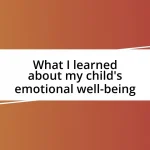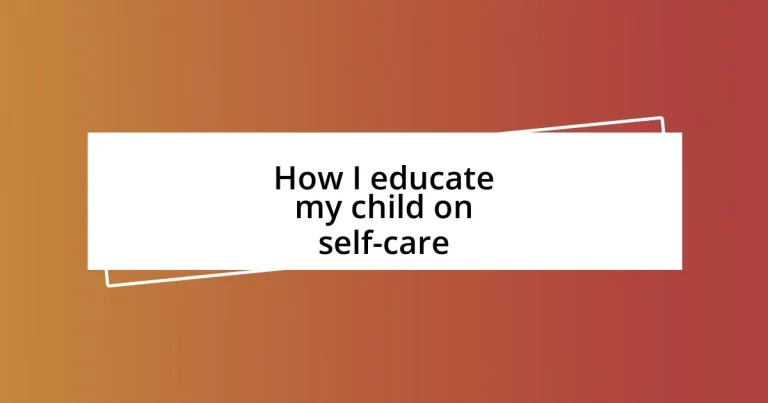Key takeaways:
- Teaching self-care goes beyond physical practices; it involves emotional recognition, validation, and creating routines that prioritize children’s well-being.
- Self-care education establishes foundational skills such as emotional awareness, boundaries, mindfulness, and resilience, essential for children’s lifelong wellness.
- Modeling self-care behaviors, including open discussions and adjusting routines based on children’s needs, fosters their understanding and practice of self-care in daily life.
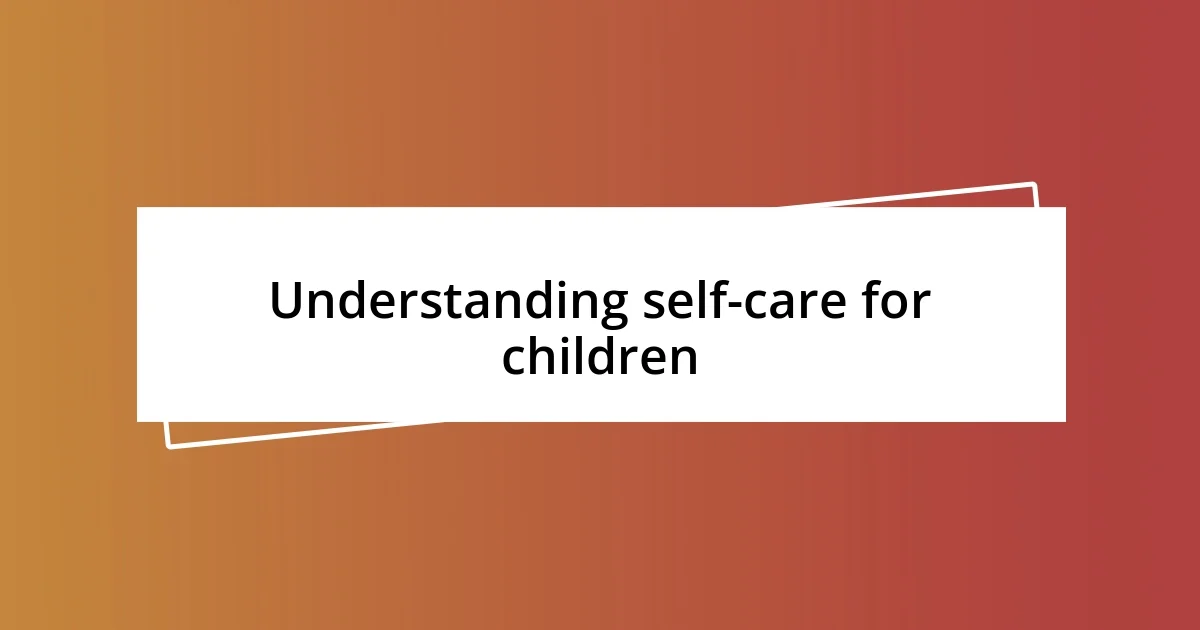
Understanding self-care for children
Self-care for children often begins with understanding their emotional and physical needs. I remember a moment when my child came home from school feeling overwhelmed. It hit me then – teaching self-care isn’t just about hygiene or exercise; it’s about recognizing and validating their feelings. How often do we overlook the importance of talking about emotions?
Instilling self-care habits in children can be as simple as creating routines that prioritize their well-being. For instance, we’ve made it a family practice to unwind together each evening. It’s during these moments that my child learns to express thoughts and feelings, realizing the importance of downtime. Have you ever noticed how a simple bedtime story can ease their worries?
Moreover, children need guidance in recognizing when they need a break. I recall a day when my child refused to take a nap, insisting they weren’t tired. After a gentle conversation, they finally surrendered and fell asleep. This taught us both a valuable lesson: the ability to listen to one’s body is a fundamental aspect of self-care that I cherish sharing with my child.
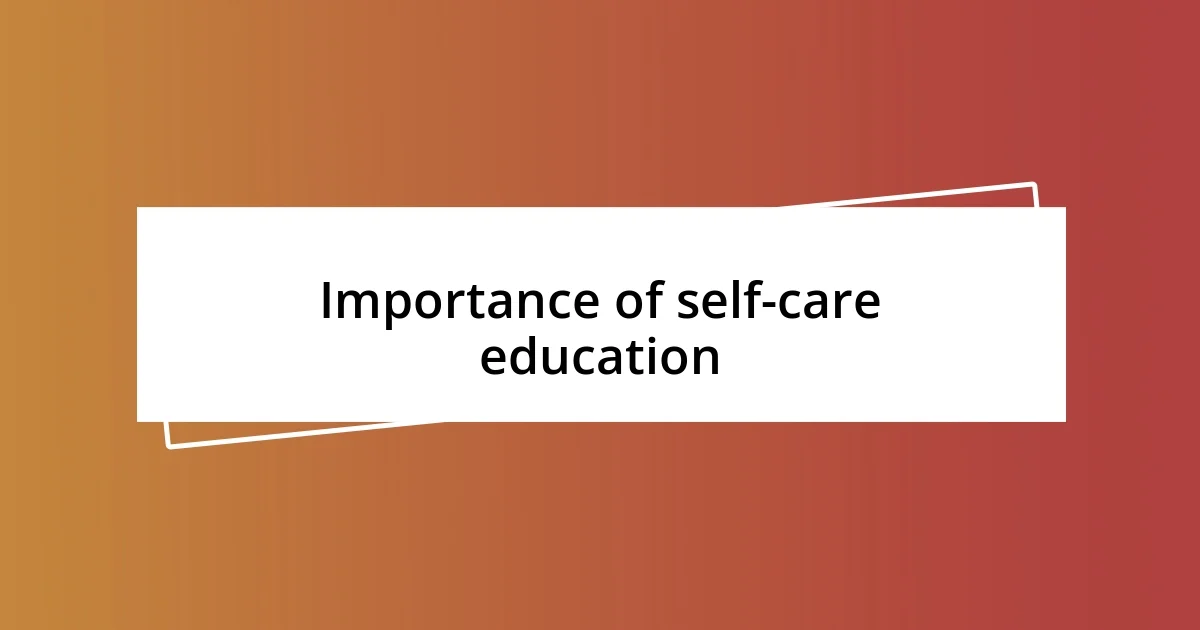
Importance of self-care education
When I think about the importance of self-care education for children, it strikes me as foundational for their overall development. The skills they learn now will shape their approach to stress and emotional regulation later in life. I often reflect on how, during a particularly busy week, I encouraged my child to take a moment for themselves—a simple five-minute break turned into a vital lesson in recognizing individual needs.
Self-care education lays the groundwork for lifelong wellness by teaching skills like:
- Emotional Awareness: Understanding and expressing feelings without fear.
- Physical Well-being: Learning the impact of nutrition, exercise, and rest.
- Boundaries: Recognizing when to say no or step back from a situation.
- Mindfulness: Engaging in practices that foster calmness and focus.
- Resilience: Building the capacity to cope with setbacks and challenges.
It’s these essentials that not only prepare them to face life’s hurdles but also empower them to prioritize their well-being. Each small step in educating my child feels like a building block for a healthier, happier future.
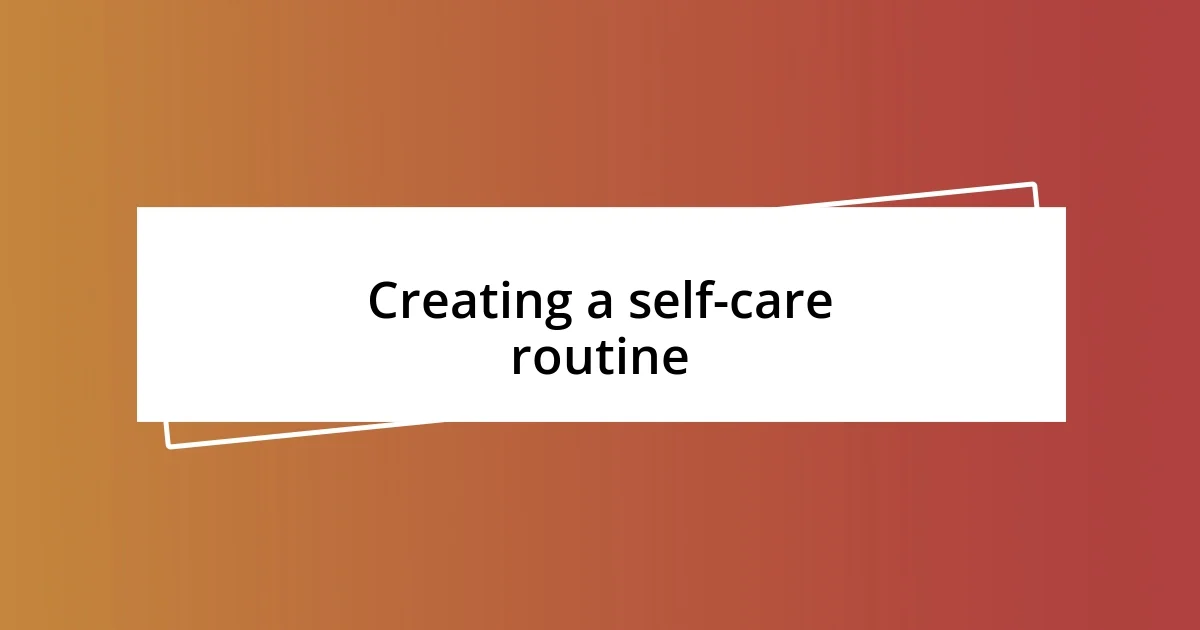
Creating a self-care routine
Creating a self-care routine for my child has become a delightful journey instead of a chore. I started by including small, manageable tasks during our daily schedule. We set aside time for activities like drawing, reading, and just sitting quietly together—it’s amazing how such simple moments can instill a sense of peace and routine. I remember the first day we tried this: my child smiled and said, “This is our special time,” which made me realize the significance of transforming self-care into something they truly cherish.
It’s crucial to involve my child in the process of creating their self-care routine, allowing them to explore what makes them feel good. For instance, I once asked my child to choose a favorite activity to include, and they picked baking. It became a bonding experience, mixing flour and laughing when things didn’t go as planned. These moments not only foster our relationship but also teach them that self-care is about joy and creativity. Have you ever thought about how a little kitchen chaos can turn into a life lesson about patience and fun?
Of course, it’s vital to balance structure with flexibility. Some days, my child comes home drained and just wants to unwind with a movie instead of doing their usual activities. In those instances, I emphasize that it’s okay to adjust the self-care routine based on their feelings that day. This approach teaches them that self-care isn’t rigid; it adapts to their needs, making it a sustainable part of their lives.
| Structured Activities | Flexible Activities |
|---|---|
| Drawing and Reading | Choosing to Watch a Movie |
| Cooking Together | Spontaneous Playtime |
| Quiet Time for Reflection | Going for a Walk |
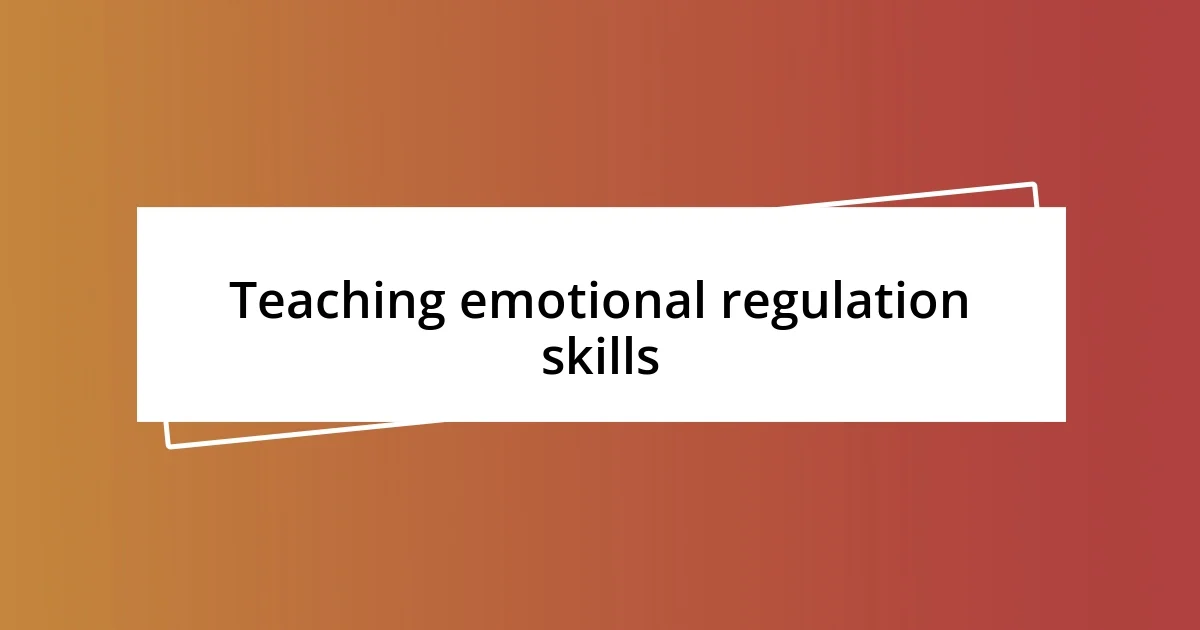
Teaching emotional regulation skills
Teaching emotional regulation is an essential piece of the self-care puzzle that I actively focus on with my child. One method I’ve found incredibly effective is using stories to illustrate how various emotions feel and can be managed. I remember one evening, while reading a bedtime story about a character who felt overwhelmed, I asked my child, “How do you think that character feels?” This simple question opened a dialogue, prompting my child to connect their own experiences with emotional vocabulary. It’s enlightening to see how just a few words can encourage them to articulate their feelings better.
Incorporating mindfulness practices has also been a game changer. When my child faces frustration, we’ve started taking a few deep breaths together—it’s become a calming ritual. One day, after a particularly tough moment at school, we sat outside together, focusing on the sounds of nature. My child marveled at how calming the gentle breeze was. Wouldn’t it be wonderful if we all paused like that more often? This practice not only helps them recognize their emotions but also provides tools they can carry into future challenges.
Lastly, I emphasize the importance of self-compassion during our discussions about emotions. I always remind my child that it’s perfectly okay to feel sad or angry and that emotions are merely signals that something needs attention. One afternoon, after a minor setback, my child expressed their feelings with, “Why do I always get upset?” This moment became an opportunity to discuss that we all have moments of vulnerability. We talked about how kindness toward oneself can transform sadness into resilience, turning struggles into stepping stones for growth. How do we teach our children to nurture that self-kindness within? By modeling it ourselves, one tender conversation at a time.

Encouraging healthy lifestyle choices
Encouraging healthy lifestyle choices goes hand in hand with making wellness enjoyable for my child. For instance, we turned grocery shopping into a mini-adventure. I assign my child the task of picking out colorful fruits and veggies, making it a fun scavenger hunt. One day, I watched with delight as they proudly selected a rainbow of produce, exclaiming, “We’re going to eat the colors of the rainbow!” That excitement makes a significant difference; it shows that health can be vibrant and engaging.
I’ve also discovered the power of movement in fostering healthy habits. We started family dance parties in our living room, which became our energetic escape after a long day. I remember my child laughing, twirling around, and declaring, “This is much better than video games!” This playful approach to physical activity not only strengthens our bond, but it also nurtures a love for movement that I hope will last a lifetime. Have you ever considered how play can transform the notion of exercise into something fun?
Lastly, instilling a sense of balance when it comes to screen time has been an important topic in our home. I recall a day when my child came to me, feeling sluggish after a long afternoon of screen time. Sitting down with them, we talked about how our bodies feel after too much sitting versus how invigorating it is to play outside. Together, we drafted a family rule: for every hour of screen time, we balance it with an hour of outdoor play. This routine isn’t just about limiting screens; it’s about fostering awareness of how different activities make us feel. Isn’t it powerful to see our children begin to make mindful choices about their own wellbeing?
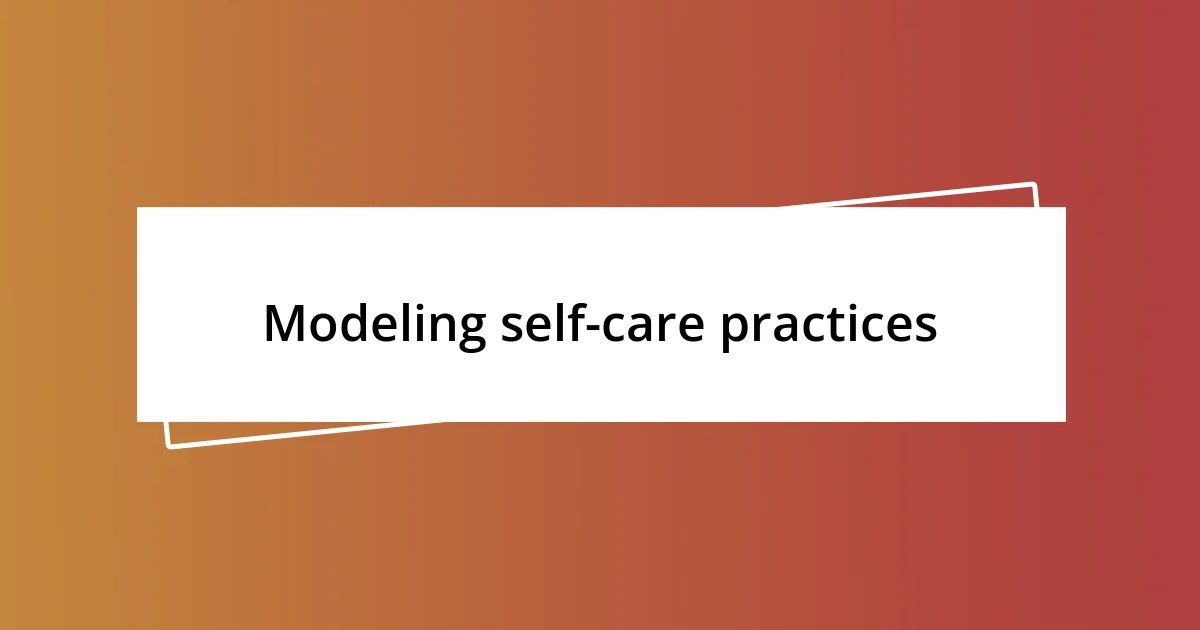
Modeling self-care practices
Modeling self-care practices starts with the simple routines we establish at home. For example, I’ve made it a point to incorporate daily moments of quiet reflection into our family life. Each morning, before the day begins, we sit together for a few minutes of silence, sipping our favorite teas. It’s a peaceful time that encourages my child to appreciate calmness and stillness. I often think, “How does this little ritual shape their approach to busy days ahead?”
During our family time, I openly discuss the importance of taking breaks when feeling overwhelmed. Just the other evening, after a hectic day, I saw my child getting frustrated with their homework. Instead of pushing them through it, I suggested we take a quick walk outside—a decision that transformed the moment. My child came back refreshed, saying, “I can think more clearly now!” It’s incredible how sometimes the simplest act of stepping out for a moment can shift their entire mindset.
Another vital aspect of modeling self-care is sharing my own experiences with self-care openly. I recall a day when I wasn’t feeling my best and decided to take a long bath. My child peeked in and asked, “Mom, what are you doing?” I replied, “I’m taking a break to recharge. We all need that sometimes.” Hearing these words, they began to understand that self-care isn’t a luxury but a necessity. This transparency not only teaches them the importance of caring for oneself but also opens the door for them to express their self-care needs in the future. Wouldn’t it be beneficial for all of us to recognize that it’s perfectly okay to prioritize our own wellbeing?
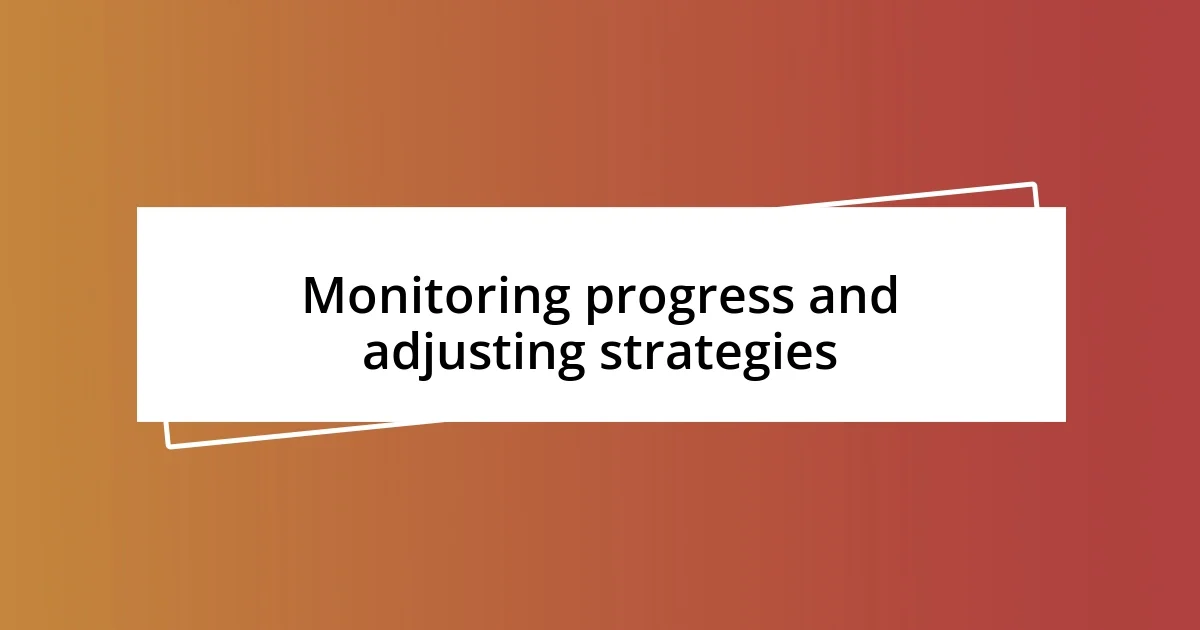
Monitoring progress and adjusting strategies
Monitoring progress and adjusting strategies plays a crucial role in my journey of teaching my child about self-care. I often keep a close eye on how my child responds to the routines we establish. For example, I remember a week where we introduced mindfulness exercises before bedtime. Initially, my child was restless and sleepy, but I noticed their mood shifted by midweek. That small change prompted me to tweak the practice, incorporating a fun bedtime story that focuses on self-awareness. Watching them engage more actively made me realize how essential it is to adapt my strategies to their evolving needs.
I find that checking in regularly can spark meaningful conversations about self-care. Just a few nights ago, as we sat down to discuss our weekly ups and downs, my child expressed feeling overwhelmed with school. It was a defining moment for both of us; we brainstormed ways to allocate homework time better and scheduled fun breaks in between tasks. This exchange made me think about the importance of being responsive, and I asked myself: how often do we really listen to our children’s feelings? I realized that offering a safe space to express themselves not only helps them make better choices but fosters emotional intelligence too.
In essence, what I’ve discovered is that monitoring progress doesn’t just help with adjusting strategies—it builds a connection. Just last month, after experimenting with different self-care activities like journaling and nature walks, I noticed my child gravitating more towards spending time outdoors. This preference became evident when they said, “Can we go outside instead of doing a craft today?” It struck me that honoring their choices would keep the self-care framework thriving. By immersing myself in their journey, I’m not just an educator; I’m a partner in their growth, helping to shape their understanding of self-care in ways that resonate deeply with them.










